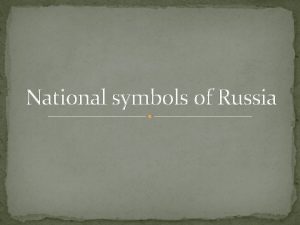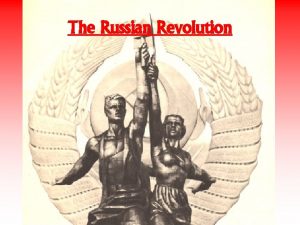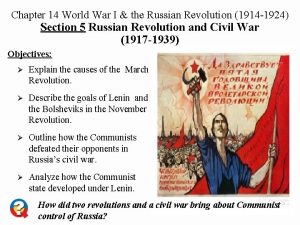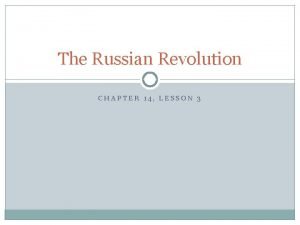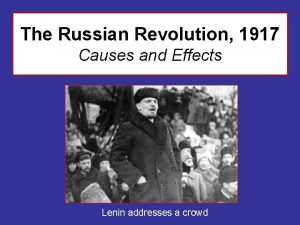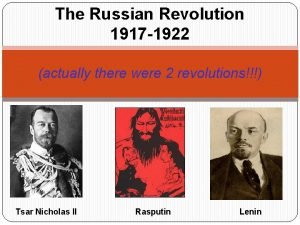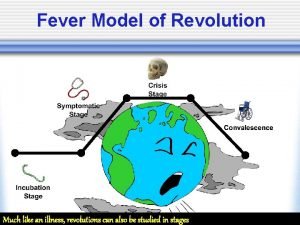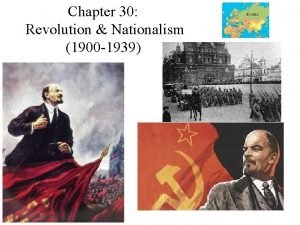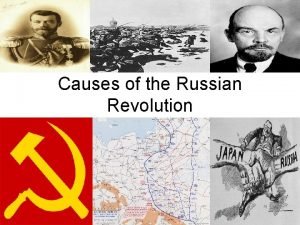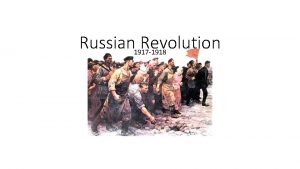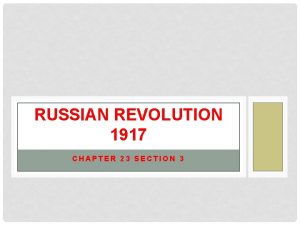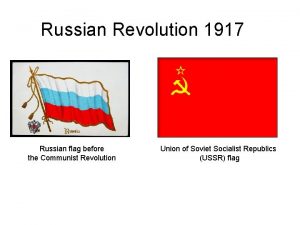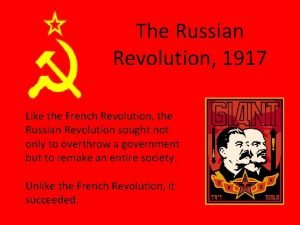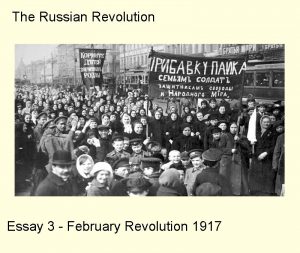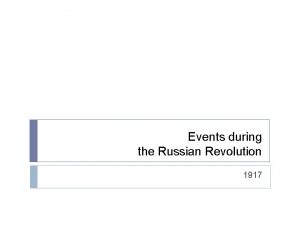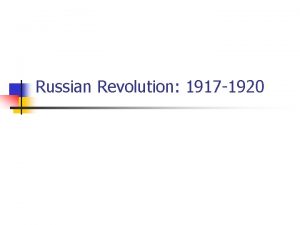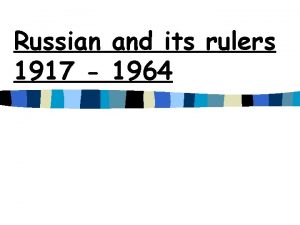The Russian Revolution CHAPTER 23 SECTION 3 1917














- Slides: 14

The Russian Revolution CHAPTER 23 SECTION 3 1917

Background to Revolution Russia was no where near prepared for the fighting that would break out at WWI. Still under an absolute monarchy with a king known as a Czar (tsar) in charge, Preparations for a long war were never in place. Czar Nicholas II took it upon himself to lead the military instead of a more capable individual with proper military training. Supplies were also low as many soliders practiced with broom sticks. As Czar Nicholas II went in to battle, his wife Alexandra was left to make all the important decisions. She began to be heavily influenced by a man named Grigory Rasputin was believed to have extraordinary powers by the Queen.

Russian Monarchy Czar Nicolas II Rasputin Queen Alexandra

Background to Revolution Many Russians were angry with the decisions made by the Queen. The monarchy even began to lose the support of the aristocracy. They blamed Rasputin and eventually killed him. In march of 1917 women working in factories began to strike. The government began to interfere with the economy by forcing people to ration their food, leading to price increases. 12 hour work days were also implemented leading to more discontent among the population. The Duma or legislation body was disbanded by the Czar. They met anyways establishing a provisional government, leaving the Czar out all together.

Provisional Government Aleksandr Kerensky, the new head of the provisional government called for the continuation of the war even though Russia was beginning to have a Civil war. Soviets also tried to gain an influence in Russia during this time. Soviets were representatives of workers and soldiers functioning similarly to a union. Soviets were heavily influenced by socialism.

From Czar (Tsar) to Communist Bolsheviks, a group of Marxist created the Russian Social Democrats. Led by V. I. Lenin, the movement eventually turned violence, starting the revolution. Lenin began travel extensively between 1900 to 1917, once the provisional government was put in place Lenin saw an opportunity for the Bolsheviks to take control of Russia. The Bolsheviks played to the portion of the population that was discontent with the way things were going in Russia. They promised an end to the war, redistribution of land to the peasants, and the elimination of private companies.

V. I. Lenin

Bolsheviks Seize Power The Soviet movement began to gain momentum, growing from 50, 000 members to 240, 000. 2 groups were organized to seize power. Soviets led by Lenin in Moscow, and Soviets led by Leon Trotsky in Petrograd, 2 of the major cities in Russia. They were able to overthrow the provisional government and establish an all-Russian congress of Soviets. Within this new organization Lenin turned over complete power of Russia to the Congress. What really happened is that a new council was created with Lenin as its leader and he had full control over Russian politics. After the Bolsheviks gain control, they rename themselves communists.

Lenin after the overthrow of the provisional government.

Bolsheviks Seize Power After so much turmoil during this change in government, it became clear that it would be difficult to control all the territory under the administration of the Czar. As a result Russia lost Ukraine, Poland, Finland the Baltic provinces. In the eyes of Lenin this was not a major loss. A staunch communist, he believed that the idea of communism was a global phenomenon. In his view these lost territories will reunite with Russia in the future once they became communists.

Civil War in Russia Turmoil soon followed in Russia once the Communists took control. You still had people loyal to the Czar who wanted to reintroduce the monarchy. Others want a constitutional monarchy and in other cases a more democratic government. Fearful of a communist take over the Allies tried to bring Russia back in to the war to limit some of the new governments authority. Eventually the allies just gave money and supplies to Lenin’s opponents in hope of removing Lenin from power. Military forces were known by 2 colors. The Soviets would be red, their enemies in white. The main battle occurred around the Volga river.

Civil War in Russia By 1920 communist forces were regularly gaining victory on the battle field. They were so successful that they were able to incorporate Georgia, Areminia, And Azerbaijan into their territory. The Russian Royal family, the Romanovs led by Czar Nicholas II were thrown in jail and eventually executed. They were captured by a group of communists in the town of Ural and burned the bodies after the murdered them. Leon Trotsky a vital leader during the overthrow of the provisional government became the head of the military with the title of commissar of war. He was ruthless killing any one who disserted the army. Russia soon dedicated much of their resources to the army instituting war communism by which supplies were regularly sent to the red Army.

The Romanov’s Russia’s Royal family

Romanov’s remains
 Russian industrialization ap world
Russian industrialization ap world Triple alliance ap euro
Triple alliance ap euro Russian revolution vs french revolution
Russian revolution vs french revolution Russian government 1917
Russian government 1917 March 1917 revolution
March 1917 revolution World war 1 and the russian revolution chapter 27
World war 1 and the russian revolution chapter 27 Kzbho6asboc -site:youtube.com
Kzbho6asboc -site:youtube.com Chapter 14 lesson 3 the russian revolution
Chapter 14 lesson 3 the russian revolution Causes and effects of the russian revolution
Causes and effects of the russian revolution Czar in russian revolution
Czar in russian revolution Russia after ww1
Russia after ww1 Russian revolution political cartoons and explanations
Russian revolution political cartoons and explanations Fever model revolution
Fever model revolution Chapter 30 revolution and nationalism worksheet answers
Chapter 30 revolution and nationalism worksheet answers Effect of russian revolution
Effect of russian revolution



